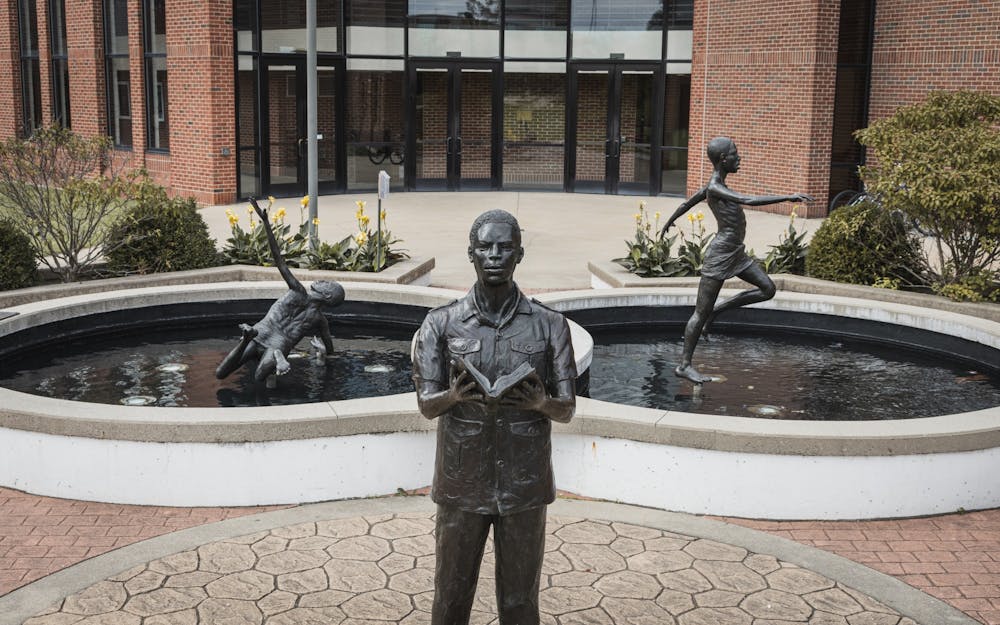There are some people whose stories become so common that they themselves become legends. Once those individuals reach legendary status, their stories no longer belong to them, but to the people who tell their stories.
These are the people like Johnny Appleseed, who has become more ubiquitous for the image of the pan on his head and the pocket full of appleseeds than anything he did on a smaller scale.
If there is anyone in Taylor’s own history that fits this description, it is Samuel Morris formally known as Prince Kaboo. Every student has heard the name. Many live in a building memorializing him or walk by his likeness in bronze on their way to “Integrative Communication'' or “Art as an Experience.” But few have stopped before his likeness and wondered who was the man behind the myth.
Morris is a Taylor figurehead whose story has been inextricably linked to the university from the moment it was recorded by one of Taylor’s most famous presidents, Thaddeus C. Reade, while Morris was on his deathbed.
The story of his life has been likened to romance novels by newspapers of the time. Though he was the prince of the Kru tribe in Liberia, he was raised in slavery to a neighboring tribe. After facing brutality from his enslavers, Morris received what he called a vision from God and escaped, twice.
From there, he made his way to a plantation along the coast. There he met Anna Knoll, a missionary with Bishop William Taylor’s organization. Morris was her first convert.
With the help of a minister and Reade, along with many donors, Morris made his way to Taylor’s Fort Wayne campus where he entered a program to learn about missions with the goal of becoming a missionary among his own people.
His time at Taylor was cut short when he died in the Spring of 1893 of dropsy, an antiquated term for what is probably congestive heart failure. He was 19years old. Reade wrote down Morris’s life story during his extended stay in the hospital. Immediately after his death, a dormitory hall was built in his honor.
This was the beginning of the trend in which Morris’s story was told by the people around him. Partially, this is because there is no extant writing from Morris himself. What is available are letters about him or to him from his contemporaries as well as two biographies — the sketch of his life by Reade and “Angel in Ebony” by Jorge O. Masa.
With the extant sources, we can piece together a bit of his life as well as his death.
Morris lived on campus from 1891–1893, coinciding with the last two years before Taylor’s campus moved from Fort Wayne to Upland.
He lived in the dormitories with everyone else while attending the academy that prepared students academically for college if they did not have the reading or writing skills to go right into classes.
Morris enjoyed an important friendship with a fellow Liberian Christian named Henry O’Neil who shared his goal of becoming a missionary to the people of Africa. In Morris’ life, he tried to convince Reade to bring O’Neil to Taylor from the university he was studying at in St. Louis.
This request was not met until 1904 when O’Neil was brought to Taylor to complete a three-year music course. After graduating, Morris’s former friend moved to Sierra Leone where he served as a missionary, fulfilling the dream he had shared with his friend and countryman.
The word used over and over by Morris’ contemporaries to describe him is inspirational, including the writers of his death announcement in the Fort Wayne Sentinel.
Years after his death, Morris’ classmates were still talking about his effect on them.
“Sammy Morris to me was something real, never to be forgotten by those who came into contact with him,” said the Rev. A. J. Duryee in a letter to the editor of a 1934 issue of The Echo. “His holy life and Christ spirit shows in his face something more than a mortal being, but a real Christ-like man with the Holy Spirit.”
Today there remain only a few clues to who Morris was as an individual. But there are several memorials testifying to his impact at Taylor that have lasted to this day.
“I think Samuel Morris is important for Taylor because it is always important to remember those who have made a community such as this possible,” sophomore Talique Taylor said. “I think that amidst all the things we idolize here whether it be our cultural institutions or our wings or whatever it is we idolize at Taylor we need to go back to what makes life fulfilling and that is sharing the gospel.”
A special thank you to the Ringenberg Archives for providing the sources for this article.





